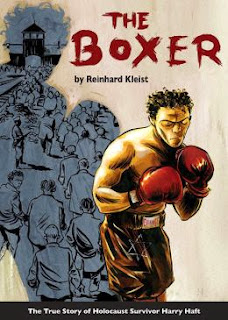Summary: Harry Haft is a survivor. This story talks of how Harry was brought up and how that upbringing helped him to survive not only in the concentration camps but also as a professional boxer in the United States. Harry was a tough man with a tough exterior, who did what he needed to do whenever necessary but even he had a breaking point, even he could only take so much. The story reveals how horrific the conditions were for the Jewish prisoners and how brutally inhumane their treatment was. Harry fought in concentration camp boxing matches for the amusement of the Nazis, who would often kill the loser of those matches. Little did Harry know that this "sport" would keep him alive for a length of period as well as provide a living for him later on in the U.S. But what the reader soon realizes is that there is a cost to his survival and it isn't for the better. Be forewarned though, in the graphic novel, there are intense, disturbing moments that may make some readers squeamish and may leave some indelible images. Nevertheless, this is a great story of a first-person experience that describes the inexplicable Holocaust and how strong the will to survive is.
Reference: Kleist, Reinhard (2014). The Boxer: The True Story of Holocaust Survivor Harry Haft. SelfMadeHero, London NW1 1UN.
Impressions: To be honest, the only reason I picked up this graphic novel, was because I received it from the Junior Library Guild. Plus, not being a boxing aficionado, I didn't even know who Harry Haft was. But, as soon as I began reading it, I was hooked.
Much like Art Spiegelman's Maus, the novel begins with Harry revealing his ordeal to his son. Another similarity is that their father-son relationship is strained as well. Though their characters are different, it's evident that both of the fathers are marred from their experiences and most likely effect their abilities to emotionally bond with their sons. Initially Harry doesn't come off as a likable guy but we soon see behind his tough exterior. An older Harry has an emotional break down that forces him to open up to his son and thus begins the story. Those opening pages immediately grabbed my attention and the intensity of his story kept me riveted, a story that I won't soon forget. His story is filled with anguish, sorrow, and loss. It was amazing to me how strong his will to survive was, and for that matter, the will of all of the victims, which I think is the purpose for this book. And, a very strong purpose it is.
I was not only impressed with the character of Hertzko (Harry) Haft, but also with the way Kleist draws him. The black and white illustrations provide a matching heavy atmosphere and the thick ink lines that are used for the characters perfectly fits their demeanor. The drawings aid in the telling of the story, helping me to comprehend the gravity of the story. I can't speak enough how great of a job Kleist does in his representation of Harry Haft's life. This is a graphic novel that must be read for those who enjoy graphic novels and even for those who may not.

Comments
Post a Comment